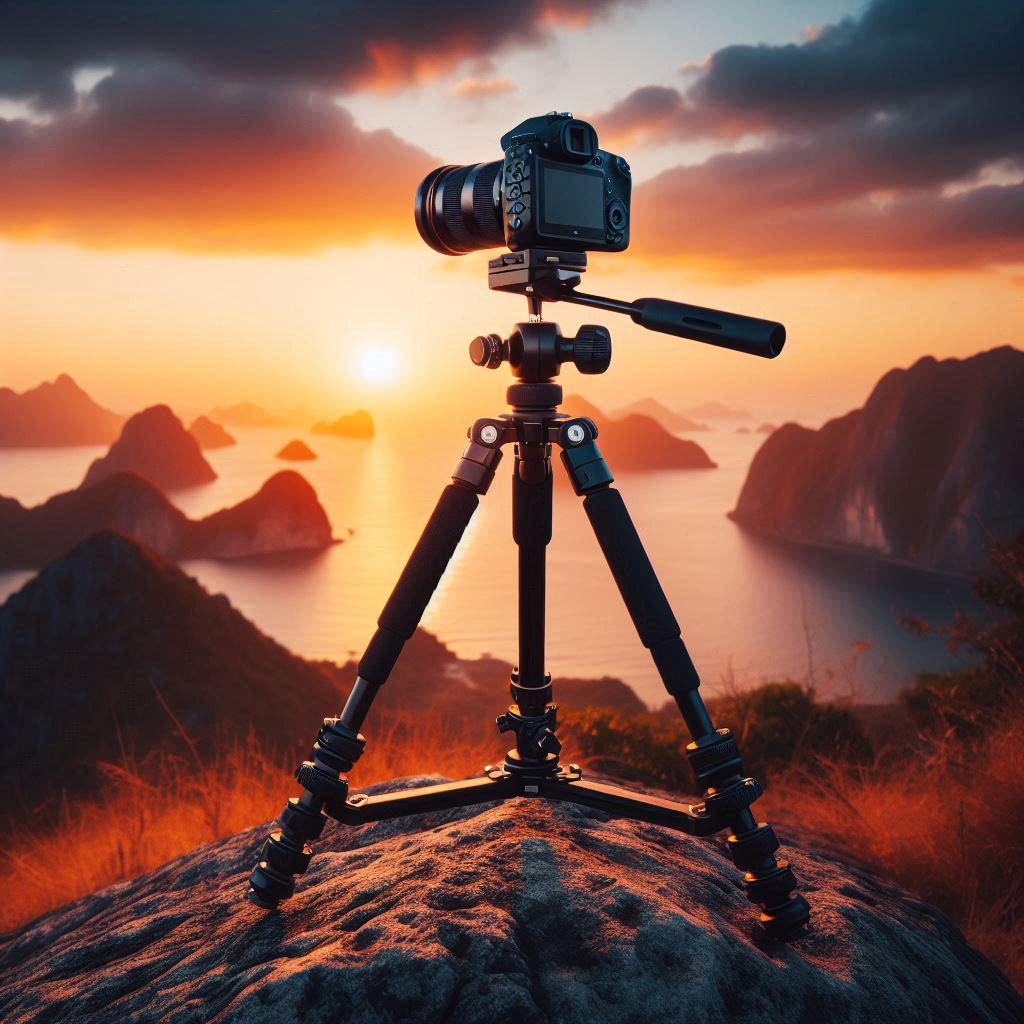
You will see many photographers carrying tripods while out on a shoot. Are they really necessary? Why is a tripod an asset you can’t afford to neglect, regardless of your expertise level in photography? This isn’t just about having a stand to rest your camera. It’s about the immense difference a tripod makes in capturing crisp, clear shots. If you’ve ever faced the frustration of blurry images or uneven landscapes, you already understand the heart of the matter: stability is king. By the end of this post, you will have a better understanding of camera tripods and why you may want to use them.
It’s A Matching Game
Now, there’s more to a tripod than meets the eye. From the casual hobbyist learning the ropes to the seasoned professional shooting in demanding conditions, tripods come in an array of styles and configurations. Later in this post, I will cover the different types of tripods designed to cater to a variety of situations and requirements. It’s about matching the right tripod to the right purpose.
Why Do I Need A Tripod?
You’re probably wondering, ‘Why do I need a tripod if I’ve got steady hands?’ Well, even the steadiest hands aren’t immune to the subtle shakes that can occur during exposure, especially under low light or when using large, heavy lenses. Ask me how I know…lol. Plus, a tripod isn’t only a tool for preventing camera shake, it’s pivotal for composing your shot with precision, enabling long exposures, and providing a consistent framework to work from if you’re stitching multiple images together.
There’s A Tripod For That
As we move into the next section, think about the kind of photography you love. Whether it’s capturing the untamed beauty of a wild animal, the serene expanse of a landscape, the dynamic intensity of a sporting event, or the intimate details of a portrait, there’s a tripod out there engineered for that purpose. Let’s explore these photographic realms together and unveil the tripod that not only complements your style but elevates it.
Tripod 101: Understanding the Basics
If you’re eager to step into the world of photography or elevate your shooting skills, mastering the fundamentals of a camera tripod is essential. The tripod serves as the three-legged spine for your camera, ensuring your shots are as sharp and as stable as possible. But what does a tripod consist of exactly? Let’s break it down.
Legs
First, you’ve got the legs. Typically, there are three (hence ‘tri-pod’), and they can be extended or collapsed to various heights. A sturdy set of legs is crucial, especially when you’re battling the elements outdoors or working on uneven ground.
Head
Then there’s the head – not yours, but the tripod’s! This is where you attach your camera, and it comes in different types, such as pan-tilt and ball heads. You’ll want a head that moves smoothly for easy composition but locks tight for shot stability.
Center Column
Let’s not forget the center column. This bit can usually be adjusted vertically and is perfect for making fine-tuning adjustments to the camera’s height, without messing with the legs once you’re all set up.
Last But Not Least
Lastly, tripods are made from various materials, each affecting the device’s weight, stability, and durability. You’ll find them in aluminum, carbon fiber, and even plastic. While the pros might eye carbon fiber for its lightweight and rigid attributes, if you are a beginner you might start with a more budget-friendly aluminum or plastic option.
As you weigh up these tripod components, remember to factor in their impacts. Think about the conditions you’ll face and the type of photography you’ll delve into. Your tripod should be your steadfast companion, not a cumbersome afterthought.
Specialized Tripods
Choosing the right tripod can be a game-changer, especially when your subjects are as unpredictable as wildlife or as vast as nature. Each photography niche has its quirks, and the tripod that works best for one might not suit another at all. Let’s take a look at the inside scoop on which tripods are best suited to specific photography scenes, and why.
Wildlife Photography
For wildlife photography, where you might be trekking across uneven terrain to catch a glimpse of elusive creatures, a lightweight, durable tripod is crucial. You’ll want something easy to carry during long walks, yet stable enough to hold your camera steady when that perfect shot presents itself. Carbon fiber tripods shine in this arena; they are light and resist vibrations well.
Landscape Photography
Capturing the serene beauty of a landscape demands a tripod that can hold firm against the elements. If you’re waiting for that perfect sunrise or sunset, a tripod with spiked feet can provide that much-needed grip on natural surfaces, preventing unwanted movement. Features like a built-in bubble level are also great for landscape photographers to ensure a perfectly horizontal horizon.
Sporting Events
When it comes to sporting events, speed is of the essence. A tripod with a smooth pan head can be crucial for following fast-paced action without blurring. Also, consider a tripod that extends quickly and easily, so you can switch positions and adapt to the unfolding event without missing a beat.
Portrait Photography
Portrait photography, however, relies heavily on achieving the perfect framing and angle with consistency. A tripod with a three-way head allows for precise adjustments in all three planes, making sure your subject is always just where you want them in the frame. And here, a little additional weight isn’t necessarily a bad thing, as it can provide the stability needed for studio settings.
Advanced Tripod Features
Choosing a tripod with the right features can take your photography to a new level, especially when you’re a professional. The nuances in tripod heads are critical, and two popular types are the geared head and the ball head. Geared heads provide precise adjustments, allowing you to fine-tune your camera’s angle with knobs. Ball heads, on the other hand, offer speed and flexibility. You can swivel the camera almost instantly in any direction, but they may lack the minute control of geared heads.
Gimbal Heads
For wildlife photographers, a gimbal head can be a game-changer. A gimbal head balances the camera and lens around its center of gravity, which means you can move extremely heavy setups effortlessly. This is ideal when you need to track fast-moving subjects without the jerkiness that can come from standard tripod heads.
Carbon Fiber
Now, let’s talk materials. Carbon fiber is the go-to for many professionals because it’s lightweight, sturdy, and absorbs vibrations well. Aluminum, though more affordable, is heavier and may not dampen vibrations as effectively, which can be a downside during long exposures.
With technological advancements, tripods now have features like retractable spikes for uneven terrain, built-in bubble levels for alignment, and counterweight hooks to add stability on windy days. I also want to point out that some pricey tripods offer modular designs, letting you replace or upgrade parts as needed, which is a wise long-term investment.
Pros and Cons of Different Tripods
Now let’s talk about the trade-offs and benefits you’ll encounter with various tripods. Your choice can greatly impact your photography, and understanding these differences is crucial for both beginners and seasoned shooters. It boils down to finding the sweet spot that complements your needs, shooting style, and budget.
WEIGHT VS. STABILITY– A lightweight tripod is a blessing when hiking through nature, but may not hold steady in a gusty wind. A sturdy one, however, can be a hassle to carry. Choose something that resonates with you, balancing the convenience of weight against the need for a stable shot.
PORTABILITY VS. EXTENSION– Travel photographers prefer compact tripods that fit in a backpack, while studio photographers prioritize height and extension for varied shooting angles. You can always adjust your approach down the line after you’ve gotten some experience with what suits your work best.
LONGEVITY AND EASE OF MAINTENANCE– Carbon fiber doesn’t corrode and is incredibly durable, while aluminum may suffer in salty, humid environments. However, aluminum tripods are generally less expensive, which might be better for your initial outlay if your budget is tight.
Final Thoughts
Finally, don’t worry too much about price in the beginning. It’s better to start with what you can afford. The PRICE VS. PERFORMANCE debate often favors premium tripods, but there are plenty of budget-friendly options that offer decent stability and features for those just starting. Your first attempt doesn’t need to be your last – you can always upgrade as your skills and needs grow.
I hope that you now have a clearer picture of the types of tripods available and the pros and cons of each. Remember, in the end, the best tripod is the one that gets used, so choose one that you’ll feel comfortable shooting with. Happy snapping!
Did you enjoy this post? Do you want to know when the next post comes out? Consider subscribing. I only send update emails once a week, usually on Friday. Try it out. You can unsubscribe at any time.
